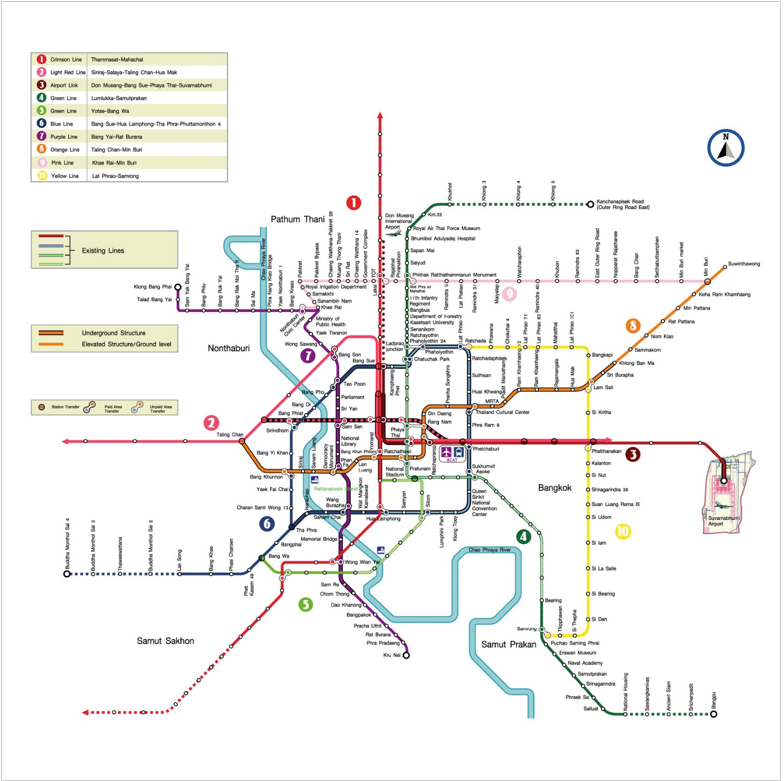PUBLIC TRANSPORTATION IN BANGKOK
Consult here our public transportation map
As of May 2017, the public transporation network was made of 4 metro/train lines and 1 fast bus line:
- Sukhumvit BTS line: first skytrain completed in Bangkok (1999), the Sukhumvit line has deeply reshaped Bangkok's city center.
- Silom BTS line: second skytrain line completed, connecting Sukhumvit and Sathorn/Silom areas at Siam station. It is crossing the River to the
west and is highly frequented by tourists.
- MRT line: underground metro completed in 2004, the only of its kind in Bangkok, high capacity and fast-growing traffic. Main hubs at Asok and Lumpini stations.
- SRT "Airport Link" line: connecting Suvarnabhumi airport to Bangkok city center (at Makkasan and Phaya Thai).
- BRT line: fast bus line linking Sathorn (Chong Nonsi) to the south part of the Riverside area and across the Chao Phraya river.
Compared to most other south-east Asian capitals, Bangkok’s public transportation network is rather well developed. Only the ultra wealthy city-state of Singapore
and the very developed - though much smaller - Kuala Lumpur have a better urban and suburban rail system.
More importantly, after several years of turnarounds and delays until 2013, the extensive development plan of Bangkok Metropolis metro and train network
is now well under way and no less than 10 metro lines (mostly operated by BTS and MRT companies) will cover the metropolis and help decrease significantly the traffic
inside and outside the center of Bangkok.
BANGKOK'S PROJECTED PUBLIC TRANSPORTATION NETWORK BY 2022

TAXIS AND MOTOTAXIS IN BANGKOK
One of the very first things expats and tourists notice in Bangkok is how abundant and cheap taxis are. One can find a taxi anywhere at any time and spend an hour in taxi for a mere 100 bath.
Taxi fees between Central Bangkok and to the airports of Suvarnabhumi and Don Muang range from 200 to 400 bath depending on where you go, and on the traffic.
Uber made a prominent entrance to the market in February 2014. Despite the already high number of taxis in town, Uber has thrived on his incomparable quality of services
with young and motivated drivers offering similar rates as regular taxis. Uber is also a safer option for women travelling on their own at night.
DRIVING A CAR IN BANGKOK
Traffic can be heavy in Bangkok, especially from 7 am to 9 am and 3 pm (end of school) to 6 pm.
Due to the particular road plan in the city center, where most streets are dead-ends, there are few major axis and the bottle-neck can be pretty bad, all the more when it rains.
We would generally not advise expats to purchase a car in Bangkok unless you absolutely need it, but if your employer grants you one as part of your expat package and/or you have
no choice for commuting, you can also consider the option of hiring a driver - this should cost you no more than 15,000 THB a month and spare you the stress and tiredness of driving in Bangkok's traffic.
Another valid option is to rent a car whenever you need it. Avis, Hertz, Sixt and the likes are all well represented in Bangkok adn rental fees are reasonable. Be aware howver
that even though your national driving license may suffice to rent a car, in case of police control you will be required to present an international or a local driving license.
CONTACT US for more information about car purchases or rental for expats.
RIDING A MOTORBIKE IN BANGKOK
Most expats who need to mobilize easily in Bangkok decide to opt for a motorbike that can be either bought to (30,000 to 160,000 THB depending on the engine) or rented
(2,000 to 4,000 THB per month). Most scooters are Honda or Yamaha-branded but most global brands are represented here, including Piaggio, Vespa, Ducatti, etc
Although it is the fastest and most efficient way to travel in town, riding a motorbike in Bangkok requires the utmost vigilance. Numerous accidents involve expats
who are riding recklessly, sometimes without wearing a helmet. Helmets are mandatory in Thailand!
So ride safely and slowly even if you are stuck in the traffic in the sun or under the rain, and you will reduce dramatically your risk.
Also, note that a specific motorbike driving license is required for bikes of all sizes and power. The international driving license only works for cars (rental and purchase).
CONTACT US for more information about how to acquire a motobike driving license and where to find the bargains